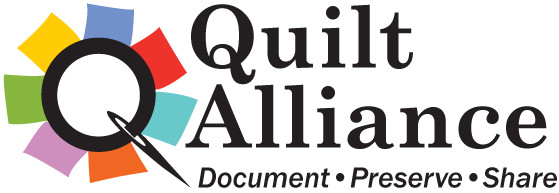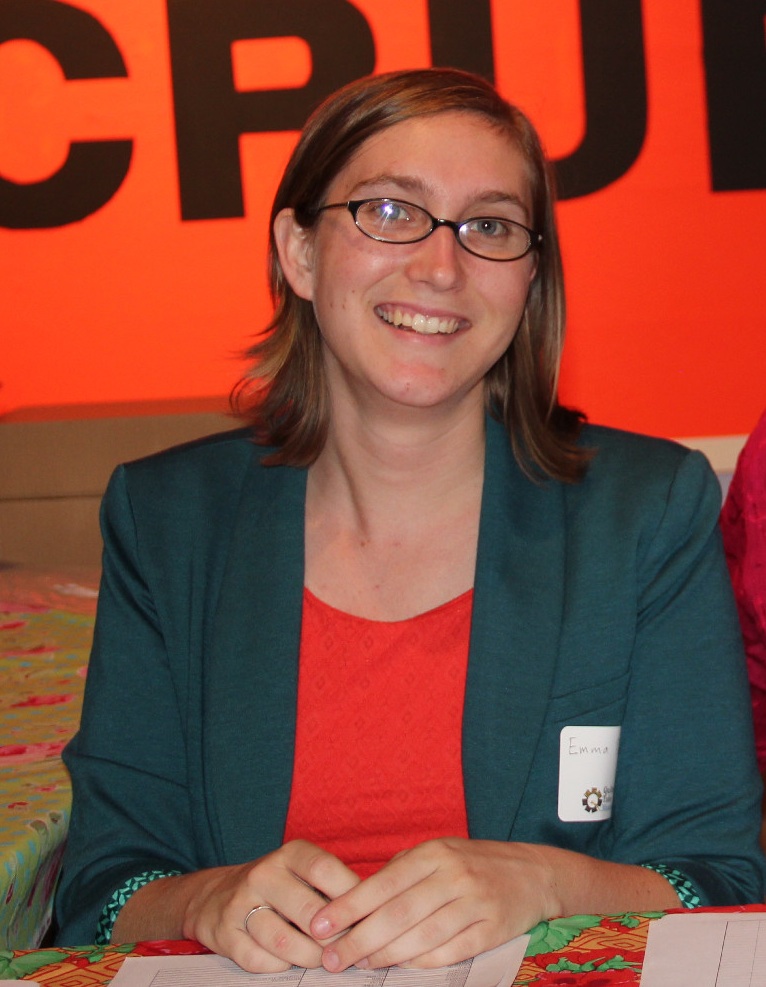Last month, Quilt Alliance board president Meg Cox and I were lucky to attend the Studio Art Quilt Associate’s annual meeting, ‘Capitolizing on Fiber’ in Alexandria, Virginia. As part of the meeting, SAQA founder Yvonne Porcella delivered an excellent lecture on early exhibits of the art quilt and SAQA’s beginnings. Check out that lecture here:
Yvonne has been interviewed for the Q.S.O.S. project 4 times. In an interview in 1999, Yvonne shared a bit about her early career, the places her work has traveled and her hopes for the next century:
 [W]hen you ask me what was my best quilt it’s most likely the last one that I have done. But I do think as I have mentioned, my career has evolved from the first brides quilt that I made as a gift, to the first art quilt I made in 1980 which was basically strips of fabric and triangles and squares of fabric, and that quilt is in the Smithsonian Collection. And that was a great honor. But that quilt was so unique it was very colorful. That quilt also traveled around the world during the early 1980’s, so the quilt has provenance. In other words, it has traveled to France for a year and traveled to Turkey, and so the Smithsonian acquired it because they wanted a quilt that. So there’s a very emotional time of my life that says that must be the very best quilt because it’s in our National Museum. But on the other hand, I’ve evolved from that point, so in 1998 I was invited to do a quilt for the International Triennial of Tapestry which hung in Lodz, Poland. That show is an Invitational of 120 Artists representing about fifty countries and they are invited to exhibit for six months in the Museum in the textile area of Poland. So for me that quilt, my quilt in that show is the coming together of my whole artistic career. I use to be a weaver. I use to weave tapestries. This was a show of the “International Triennial of Tapestries.”
[W]hen you ask me what was my best quilt it’s most likely the last one that I have done. But I do think as I have mentioned, my career has evolved from the first brides quilt that I made as a gift, to the first art quilt I made in 1980 which was basically strips of fabric and triangles and squares of fabric, and that quilt is in the Smithsonian Collection. And that was a great honor. But that quilt was so unique it was very colorful. That quilt also traveled around the world during the early 1980’s, so the quilt has provenance. In other words, it has traveled to France for a year and traveled to Turkey, and so the Smithsonian acquired it because they wanted a quilt that. So there’s a very emotional time of my life that says that must be the very best quilt because it’s in our National Museum. But on the other hand, I’ve evolved from that point, so in 1998 I was invited to do a quilt for the International Triennial of Tapestry which hung in Lodz, Poland. That show is an Invitational of 120 Artists representing about fifty countries and they are invited to exhibit for six months in the Museum in the textile area of Poland. So for me that quilt, my quilt in that show is the coming together of my whole artistic career. I use to be a weaver. I use to weave tapestries. This was a show of the “International Triennial of Tapestries.”
So I went back to my roots as a weaver and historical significance of a tapestry which told the story. It tells the story of the history at that moment. We can go back as historians and look at the flora and fauna and the costumes, of that particular moment in time that’s been showcased in the woven tapestry. I wanted my quilt that went to that show to be the sort of the dialogue of my place in this world at this moment done in quilt but with the concept of tapestry of telling a story. The quilt was done in 102 by 110 inches and done by hand. I laid the colors in and I stitched them by hand very much like I had that same mental and artistic feeling when I laid in the threads for my tapestries, but here my fabrics were large pieces, so the shapes were all reminiscent of what I have done as a weaver and building up areas of colors. The quilt is titled “Answering the Riddle” and I had proposed to myself questions about the Twentieth Century, and what do we take from the Twentieth Century, what happened in this century that will effect us in the next? The quilt has a lot of meaning to me because events and moments in time of the Twentieth Century are translated visually into that quilt, so that’s my best.
Jeri Baldwin: It sounds like it. What have you done with thinking about the Twentieth Century in your work and your teaching? What do you think you’ll change, or will you want to change, or what do you want to leave the same? What are you going to take into the Twenty-first Century as a quilter and as a teacher?
I’m still going to take the passion I have for doing it by hand. I’m going to take the passion of creating something totally for myself, that pleases myself, that comes from myself. I am not interested in scanning it on the computer. I am not interested in coloring it on the computer. Because to me the reason I am an artist, which was very difficult for me to even reach that point where that I can verbalize it because I was trained as a nurse. I was trained as a mother, as a grandmother and to be an artist was to say to people, ‘Well, I think I am an artist although I am not academically trained.’ But I have a passion and I know that if I don’t do the work that I’d be unhappy. So for me the twenty-first century will be similar to the twentieth century because I will continue to work until I can no longer work. The wonderful part of being an artist is that the wonderful ideas never stop so the concept of the creativity that will be produced in the–however long I am going to live is very exciting to me.
You can read more quilt stories on the Quilters’ S.O.S.- Save Our Stories page on the Quilt Alliance website.
Posted by Emma Parker
Project Manager, Quilters’ S.O.S.- Save Our Stories
qsos@quiltalliance.org

